RHYS DAVIDS: BUDDHIST INDIA
Chapter VIII
Writing — Its Development
IT may be asked why the Indian merchants who brought the knowledge of the alphabet from Babylon to Western India did not also bring the method, then carried in Babylon to so great a degree of success, of writing — and of writing not only mercantile memoranda but also books -on clay tablets, on bricks.
The problem is not without difficulty. But it does not arise only in India. Elsewhere also the traders or tribes who learnt the alphabet in the Euphrates Valley never adopted the habit of writing on bricks. Bricks and tablets and seals, all of them of clay, have been found, indeed, in widely separated parts of India, with letters, and even sentences, inscribed upon them. But the letters on the bricks, though most interesting as palceographic evidence, are merely mason's marks; the inscribed clay tablets contain only short sentences of scripture; and the legends on the seals are only of the usual kind. The fact remains, therefore, that clay was not in any general use among the people as a [122] material for writing books upon, or even short communications. As a specimen of writing on clay the annexed figure of a tablet discovered by Dr. Hoey,
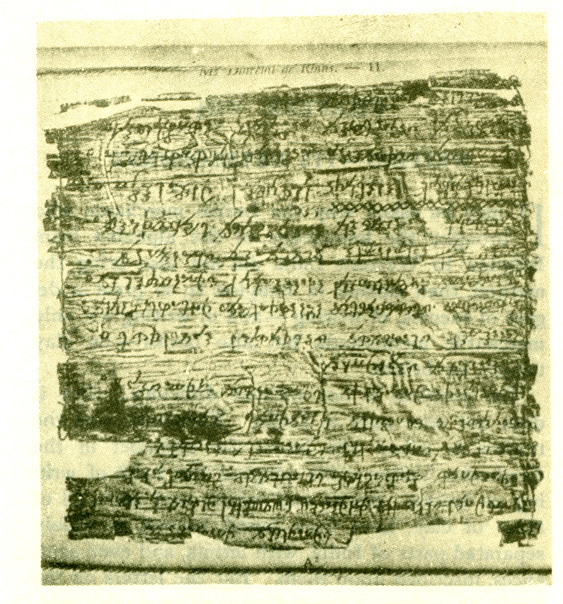
Fig. 26 Leaf of Ms. from the Gosinga Vihāra of an old Buddhist anthology
by whose kindness I am allowed to reproduce it, is interesting. It contains a Buddhist tract. Of course copper and gold plates were early and often
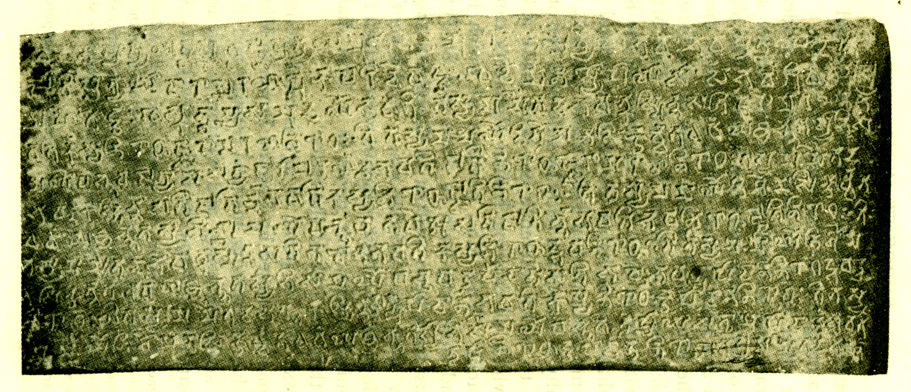
Fig. 27 Dr. Hoey's Brick Tablet, with Buddhist sutta inscribed on it.
[124] used, of which the Takshila copper plates and one of the Maung-gon gold plates are here shown.
On the other hand we have abundant evidence, both literary and archæological, of the use for such purposes of birch bark and palm leaves. The oldest specimen of a book in such writing hitherto discovered is the MS. found in the ruins of the Gosinga Vihāra; thirteen miles from Khotan. This MS. is written with ink on birch bark in letters of the Kharo.sṭrī alphabet, an alphabet introduced overland into the extreme north-west of India about 500 B.C., and used locally in Gandhāra (side by side with the other alphabet to which reference has been made above, and to which all existing Indian alphabets can be traced back).[1] This MS., portions of which have just found their way both to Paris and St. Petersburg, must have been written in Gandhara shortly before or after the Christian era. And it contains an anthology of Buddhist religious verses taken from the canonical books, but given in a local dialect, younger than the Pāli of the texts.[2]
The next MS. in point of age is much younger. It is the one discovered by Captain Bower in Mingai, near Kuchar, containing medical receipts and formulas for snake-charming, and written in characters of the fourth or perhaps the fifth century A.D., with
![The copper plate from Takkasila Fig. 28 The copper plate from Takkasila [Epigraphia Indica, Vol. IV]](../../resources/dhammatalk/rd_buddhist_india/bi_fig.028.jpg)
Fig. 28 The copper plate from Takka-silā [Epigraphia Indica, Vol. IV]
![The Maung-gon Gold Plate. Fig. 29 The Maung-gon Gold Plate. [From Epigraphia Indica, Vol. V., p101.]](../../resources/dhammatalk/rd_buddhist_india/bi_fig.029.jpg)
Fig. 29 The Maung-gon Gold Plate. [From Epigraphia Indica, Vol. V., p101.]
ink, on birch bark cut to imitate palm leaves. These leaves are also pierced with holes, through which a string can be passed to keep the leaves together — a plan always adopted for palm leaves, but very unsuitable for birch bark, which is so brittle that the string is apt to tear and break the leaves, as it had done in this case. The language used in this MS. is sufficiently near to classical Sanskrit for it to be called Sanskrit. But the five different short treatises of which this MS. consists contain, in varying degree, a good many colloquialisms[3] Other MSS. of great
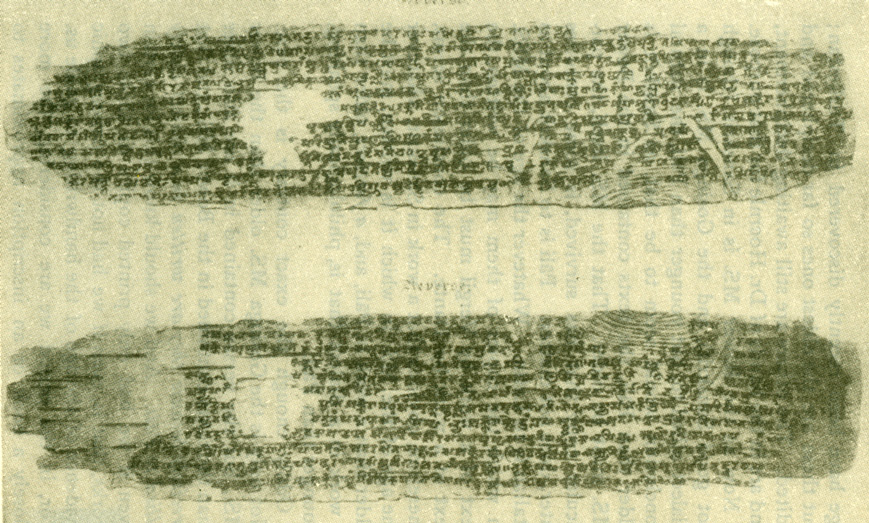
Fig. 30 Leaf from the Bower Ms. Birch Bark Cut to Imitate Palm Leaves, with holes for strings to tie them up with.
[128] age have been recently discovered in Turkestan; but these are the oldest ones so far deciphered and edited. The others are still awaiting decipherment, and are. in the hands of Dr. Hoernle for that purpose.
Now as the Bower MS. is in Sanskrit (though not good Sanskrit), and the Gosinga MS. is in a dialect allied to, but younger than Pāli, the natural conclusion would seem to be that, as Sanskrit is older than Pāli, the texts contained in the Bower MS. must be older. That the MS. itself, the particular copy that has survived, is some centuries later, does not matter. Pāli is to Sanskrit about as Italian is to Latin. Whatever the age of the MSS. in which the copies of them may be written, the text of a work by Vergil must be older than the text of a work by Dante. The conclusion seems, therefore, obvious that a work in Sanskrit, whatever the age of the MS. in which it is written, must be older than a work in Pāli, and, a fortiori, older than a work in a dialect that is, philologically speaking, younger than Pāli.
Oddly enough the exact contrary is the case. Not only is the Gosinga MS. older than the Bower MS., but the verses contained in it are also older than the texts contained in the Bower MS., and that precisely because they are wrtten in a dialect closely allied to Pāli. And we should know this for certain even if we had only printed copies of these two works, that is, even if we had not the palæographic evidence of the age of the handwriting to guide us. For, in the period we are considering, the more closely a book or an inscription approximates to
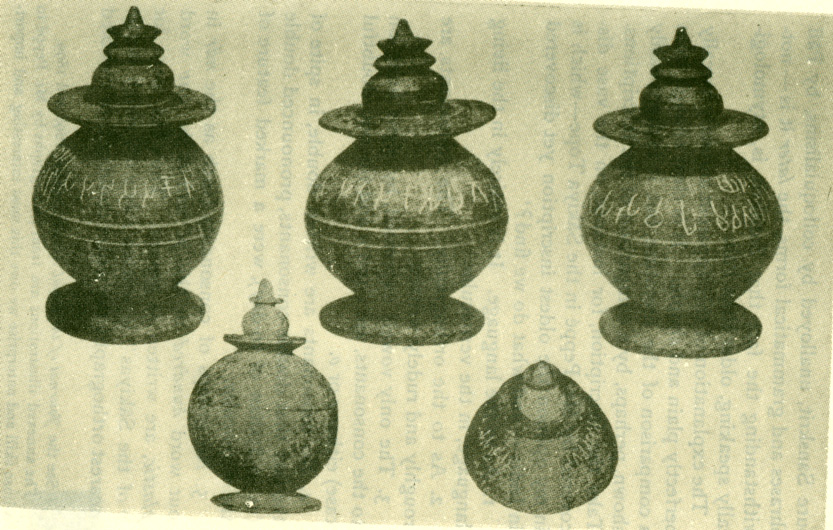
Fig. 31 The inscribed vase from the Sākiya tope.
[130] pure Sanskrit, unalloyed by colloquialisms, by Pāli phrases and grammatical forms, the later it is — notwithstanding the fact that Sanskrit is, etymologically speaking, older than Pāli.
The explanation of this apparent anomaly is really perfectly plain and simple. It is clear enough from a comparison of the literature, but it is more easily shown, perhaps, by a comparison of the inscriptions. Take the inscription, for instance, on the vase discovered by Mr. Peppe in the Sakiya Tope-which is in my opinion the oldest inscription yet discovered in India — and what do we find?[4]
1. As to the language. It is entirely in the living language, in the vernacular.
2. As to the orthography. The consonants are roughly and rudely written.
3. The only vowels expressed, by signs hung on to the consonants, are i and u and (in one doubtful case) either e or o.
4. No consonants are written double, in spite of the fact that double consonants, pronounced double (as in Italian of today), were a marked feature of the vernacular.
5. No groups of consonants (such as the ndr in our word hundred or the pi and st in our word plastic, are written as groups. Thus the word for "of the Sakiyas" is written s ki y nm, which is the nearest orthography the writer could get, or troubled [131] himself to get, for the word as spoken in the living local dialect. This may have been either Sākiyānaṃ or Sakkiyānaṃ (pronounced Sak-kiyānang).
It will be noticed that the orthography, there fore, is very imperfect. It is, strictly speaking, not so much an alphabet as a syllabary. The light
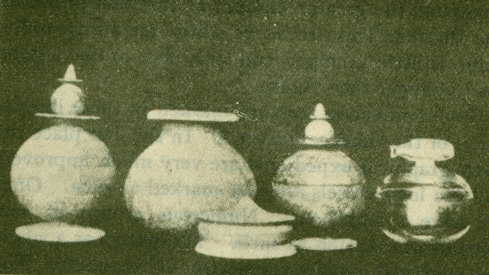
Fig. 32 The Peppé vases. Found by Mr. Peppé in the Sākiya Tope.
vowel a, pronounced as in our word vocal, is supposed inherent in every consonant on to which no other vowel is hung. No attempt is yet made to distinguish between long and short vowels. No diphthongs are written. There is no expedient as yet to show that a consonant is to be pronounced as a final, that is, without the inherent a; and this, together with the absence of groups, is what renders it impossible to express the double consonants so frequent in the actual language.
[132] The next stage we have (that is, at present; no doubt as soon as archreological explorations are carried on systematically in India intermediate stages will be available) are the Asoka inscriptions. Of these thirty-four have so far been found, and M. Senart, in his Inscriptions de Piyadasi, has subjected all those discovered before 1886 to an exhaustive and detailed analysis. With these ought to be compared the greater number of the inscriptions on the Bharhut Tope, some of which are a little older, some a little younger, and only one or two a good deal younger than Asoka.
Two tendencies are very marked in these inscriptions of the third century B.C. In the first place the orthographical expedients are very much improved. All the long vowels are now marked as such. Once we have a diphthong. Numerous groups of consonants are written as such. The letters as a whole are engraved much more neatly and regularly. The alphabet tends, therefore, to be much more accurate, more phonetic, fuller, more complete.
On the other hand, the scribes or engravers, or both, have fallen into the habit of giving expression in their orthography to what they conceived to be the more learned and more proper forms of words, and of grammatical inflexions, rather than to the forms actually in use in the real, living language. The alphabet tends, therefore, to be much less accurate, to give a less faithful picture of the living speech.
This last tendency is exactly analogous to what happened when our own spelling was being set-
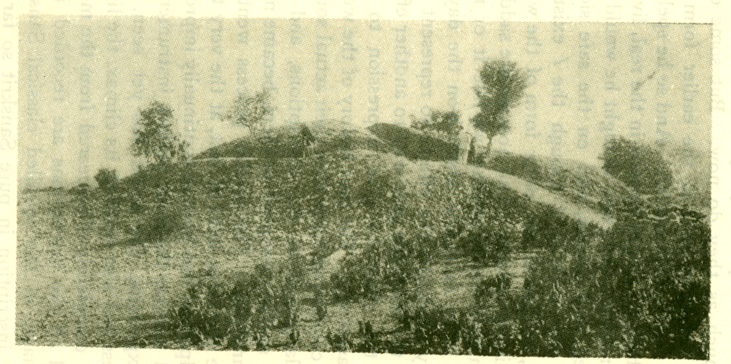
Fig. 33 Ruins of the Sākiya tope, put up by his relatives over their portion of the ashes from the funeral pyre of the Buddha.
[134] tled. Englishmen probably pronounced would and could much as they do now. But some one knew there had been an l in the earlier form of would (as in the German wollte). And so he spelt it with an l, which no longer existed in the real, living speech. Somebody else (who thought he would be quite learned, and proper, and on the safe side), spelt could also with an l, though the l existed, in this case, neither in the older form of the word nor in the living speech. And now we are saddled with the l in both words whether we like it or not. It was this latter tendency which won the day in India. Very gradually the efforts to represent the real facts of the language gave way to another effort altogether, the effort to give expression to the learned phraseology. The past history of the words came to be considered more than their actual sound. Both the language in the inscriptions, and the methods of spelling adopted in them, became more and more artificial. The double process went on through the centuries, until at last, at the very time when the alphabet had been so continually improved that it had become the most perfect instrument of phonetic expression the world has yet seen, the other process had also reached its climax, the living speech had completely disappeared from the monuments, and all the inscriptions are recorded in a dead language, in the so-called classical Sanskrit. The oldest inscription in pure Sanskrit so far discovered, that of Rudradaman at Girnar in the Kathiawad, is dated (no doubt in the Saka Era) in the year 72. It belongs, therefore, to the middle of [135] the second century after Christ. It had taken four centuries from Asoka's time to reach this stage. And though the end was not yet, and inscriptions in
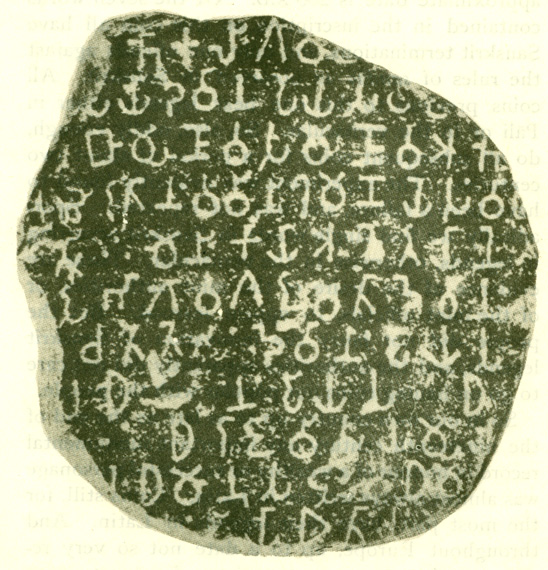
Fig. 34 Fragment of the 13th rock edict of Asoka, discovered by Professor Rhys-Davids at Girnar
the vernacular, pedantically contorted, are still met with, from the fifth century onwards the dead language reigns supreme.
The case of the coins is, if possible, even more in- [136] structive. The oldest coin which bears an inscription in Sanskrit is a unique coin of Satyadāman, belonging to the western Kshatrapa dynasty, whose approximate date is 200 A.D.[5] Of the seven words contained in the inscription on this coin all have Sanskrit terminations, and only one offends against the rules of sandhi as observed in Sanskrit. All coins previous to this one bear legends either in Pāli or in the vernacular. So, also, oddly enough, do all subsequent coins for a period of about two centuries. The experiment was evidently found to hav~ been a failure, and was not repeated. Sporadically we find single words in Sanskrit occurring in legends, otherwise in the vernacular. These are evidence of the desire of the mint authorities, or of the mint officials, to appear learned. But the people did not fancy the innovation of Sanskrit legends, and the authorities apparently did not care to go on issuing coins not popular with the people.
So in our own country up to as late as the end of the nineteenth century any important monumental record in honour of a wealthy or successful personage was almost always written in Latin. Coins still, for the most part, have their legends in Latin. And throughout Europe, up to a date not so very remote, works on a great variety of subjects were written, and education was often carried on, in that language.[6] We have never reached the point, reached in the fifth century A.D. in India, that the [137] dead language was exclusively used. But we were not so very far from it. And the conditions as to this matter in the two continents — for India is more of a continent than a country — were more similar than is often supposed. The dead language in each case was the language used in the sacrifice. The greater credit attaching to it was largely of a religious nature. But it was also a sort of lingua franca widely understood through many countries in which many various languages were respectively the language of the people. There was a time in each case when the clergy were in great part the main custodians of the learning of the day, so that the language of the church was the most convenient language in which to appeal to a larger circle of educated people than could be reached through any one vernacular. And in each case those who first used the vernacular were the men who wished to appeal to the people, who were advocating what they deemed to be reforms.
There are, of course, differences also in these two cases. The most important of these is that, in India, the use of the vernacular came first in order of time. And one result of this was the curious dialect half-way between the vernacular and the dead language, which may be called eqully well either mixed Sanskrit or mixed vernacular, according as it approximates more or less to the one or to the other. Another result was that, the vernacular being taken so early, the grammatical terminations still survived in it in a shape more or less akin to those in use in the dead language. When [138] Dr. Johnson overlaid his English with a mass of Latin words, the process stopped at a kind of hybrid vernacular. When the Indian writers before and after the Christian Era did the same sort of thing, and began to adopt also the Sanskrit grammatical terminations, the end was inevitable. When they made use of a mixture of some real forms and words drawn from the vernacular, some such words slightly altered to make them look more learned, and some forms wholly artificial with no existence at all in living speech, the only possible consequence was that the first sort were called vulgar, the second blunders, and only the third declared to be right. The hybrid they thus made use of became increasingly too like Sanskrit to be able to contend against it; and from the end of the fourth century the latter alone was used, Then, linguistically speaking, death reigned supreme. The living language was completely overshadowed by the artificial substitute. The changeling had taken the place of the rightful heir. The parasite had overgrown and smothered the living tree from which it drew its sustenance, from which it had derived its birth.
The loss, from the point of view of intellectual advancement, must have been very great. Who can doubt that Europe was fortunate in escaping (and it was a very narrow escape) a similar bondage? Classical Sanskrit, in consequence very largely of the rich fortune it had inherited from the vernacular as previously cultivated, — for Pāli is not much farther removed from the vernacular than, say, Hume's Essay from the spoken English of the day, [139] — is rich in varied expressions. But, with its long compounds and its poverty in syntax, it is cumbrous and unwieldy as compared even with the Latin of the Middle Ages, and much more so if compared with any living tongue. It must be a disadvantage to write in any language in which one does not habitually speak and think. And the disadvantage is not lessened when the existing works in that language are charged with an unprogressive (not to say reactionary) spirit in religion, philosophy, and social views of life.
It is therefore clear why Pāli books written in India, or books in a dialect allied to Pāli, or in a mixture of such a dialect and forms taken from pure Sanskrit, are each of them older than the books written in classical Sanskrit; and why a coin, a book, or an inscription, in so far as its language approximates to the regular Sanskrit, is later, and not earlier, The vernacular; was used first. Then, gradually, what were considered more learned forms (taken from the dead language used in the priestly schools) were, in a greater and greater degree, made use of, till, finally, the regular Sanskrit became used exclusively.
[1] The name of this alphabet has always been spelt Kharo.sṭhī. But Professor Sylvain Levi in his just published article in the Bulletin de l'école français d'extrême-orient for 1902 has clearly shown that the right spelling is as above, and that the Kharostra is simply the name of a country, to wit, Kashgar.
[2] See Senart in the Journal Asiatique for 1898; and compare Rh. D.'s note in the J.R.A.S. for 1899.
[3] I See now, on this MS.. Dr. Hoernle's magnificent edition of the texts, with lithographed reproductions, transliterations, and translations. Professor Bühler's preliminary remarks on it are in the fifth volume of the Vienna Oriental Journal.
[4]
See the Journal of the Royal Asiatic Society, 1898 and 1899.
The annexed illustrations are from photographs by Mr. Peppé to whose skill and enterprise we owe this most interesting and important addition to our knowledge.
[5] Rapson in the J. R. A. S. 1899. p. 379.
[6] Even in 1855, the first Pāli text edited in Europe was edited with Latin introduction, Latin notes, and a Latin translation.
Next: Chapter IX: Language and Literature I. General View
Previous: Chapter VII: Writing — The Beginnings
[Preface] [Table of Contents][1. The Kings] [2. The Clans and Nations] [3. The Village] [4. Social Grades] [5. In the Town] [6. Economic Conditions] [7. Writing — The Beginnings] [8. Writing — It's Development] [9. Language and Literature. I. General View] [10. Literature. II. The Pāḷi Books] [11. The Jataka Book] [12. Religion — Animism] [13. The Brahmin Position] [14. Chandragupta] [15. Asoka] [16. Kanishka] [Appendix] [Index]
[Home] [Sutta Indexes] [Glossology] [Site Sub-Sections]